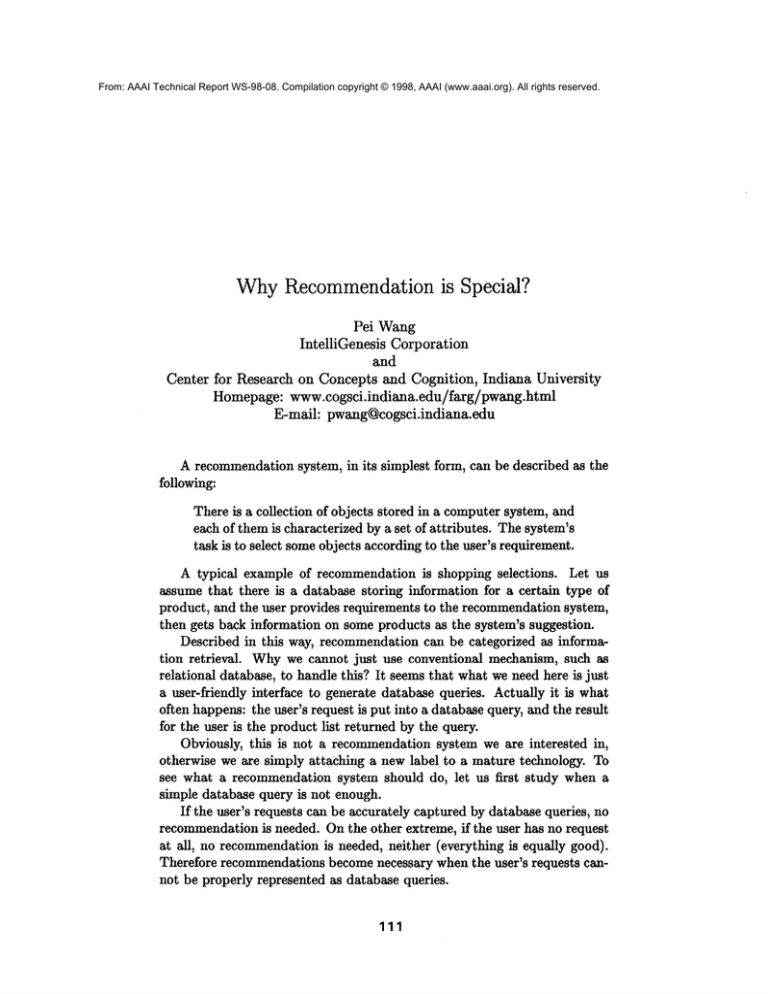
From: AAAI Technical Report WS-98-08. Compilation copyright © 1998, AAAI (www.aaai.org). All rights reserved.
WhyRecommendation
is Special?
Pei Wang
IntelliGenesis Corporation
and
Center for Research on Concepts and Cognition, Indiana University
Homepage: www.cogsci.indiana.edu/farg/pwang.html
E-marl: pwang@cogsci.indiana.edu
A recommendationsystem, in its simplest form, can be described as the
following:
There is a collection of objects stored in a computer system, and
each of them is characterized by a set of attributes. The system’s
task is to select someobjects according to the user’s requirement.
A typical example of recommendation is shopping selections. Let us
assume that there is a database storing information for a certain type of
product, and the user provides requirements to the recommendationsystem,
then gets back information on some products as the system’s suggestion.
Described in this way, recommendation can be categorized as information retrieval.
Whywe cannot just use conventional mechanism, such as
relational database, to handle this? It seems that what we need here is just
a user-friendly interface to generate database queries. Actually it is what
often happens: the user’s request is put into a database query, and the result
for the user is the product list returned by the query.
Obviously, this is not a recommendation system we are interested in,
otherwise we are simply attaching a new label to a mature technology. To
see what a recommendation system should do, let us first study when a
simple database query is not enough.
If the user’s requests can be accurately captured by database queries, no
recommendationis needed. On the other extreme, if the user has no request
at all, no recommendationis needed, neither (everything is equally good).
Therefore recommendations become necessary when the user’s requests cannot be properly represented as database queries.
111
For a single attribute, a database query can pick up entries whose attribute value falls into a certain range. However,to specify such a range is
not always as easy as it seems to be.
For example, if you want to buy a computer but have little technical
knowledge, you mayknow that you want something runs fast, and can store
lots of data, but may not be able to specify intervals for CPUspeed, RAM
capacity and hard-disk volume.
Even in familiar domains, intervals maynot serve you well, unless you
know the distribution of the data. For example, if you were looking for a
flight that departs around 9am, the interval [8:55am, 9:05am] might be too
narrow (since there was no matching flight), while the interval [7 am, 11 am]
might be too wide (since you got 50 matching flights). Even wheninterval
[8:50 am, 9:10 am] gave you exactly one flight, you might had missed a better
one at 8:49 which was much cheaper and arrived much earlier.
In summary,an interval corresponds to a binary distinction: all values
inside are equally good, so they are provided to the user without additional
help; all values outside are equally bad, so they are withdrawnfrom the user.
However, our preference to an object is often a matter of degree, which is
determined in the comparison with other objects. If only one attribute is
under consideration, the most natural solution is to sort the objects according to the request (such as "as fast as possible" or "as close to 9 am is
possible"), then show the top objects to the user.
Though a simple solution, this method already shows some fundamental features that distinguish a recommendation systems from conventional
information retrieval systems:
Whatreally matters is the relative value, not the absolute value, of
the attribute -- 11 am may be considered as very close to 9 am if all
other flights depart in the afternoon.
To really help the decision of the nser~ the recommendedobjects cannot be too few or too many-- there are always "other factors" that
cannot be put into the request, so to return the top one object turns
the recommendation system into a decision making system, while to
return the top one hundred objects leaves too muchfor the user to do.
Intuitively, the default number of recommendations should be 5 to 10,
and the user should be allowed to change this default for special situations.
The above method can be extended to handle multiple attributes.
At
first, each attribute is processed separately, and every object gets a score
112
according to the relative ranking of its value, then a total score is calculated
for each object, which is the weighted average of the individual-attribute
scores. Here the weights are specified by the user, reflecting the relative
importance of the attributes for the final decision. In this way, conflicting
requirements on difference attributes can reach a reasonable overall compromise (just as we often prefer a computer which is a little slower but much
cheaper).
The weighted-average is not necessarily the most natural operator to use
in all situation. For example, if only two attributes are considered, where
one is the amount of something, and the other is the total price, then a
more reasonable ranking index is the unit price, which is the quotient of the
two attribute values. However, the usual situation is that there are more
attributes to be considered, and there is no obvious methodto combinetheir
values into a single ranking index. In this situation, the weighted-average
operator is preferred, because it is domain-independentand well-justified.
For the above idea to work, the key technical issue is the scoring function,
which needs to be
data-sensitive, so it will be adjusted automatically whenthe data changes
(For instance, CPUis getting faster and cheaper all the time, and we
do not want to manually redesign the score function with each change
in the data), and
well-justified,
so the user can understand the principles used to get the
recommendations and the scores.
Such a recommendation system is available at
http : ///www. cogsci, indiana, edu//fa rg//peiwa ng/~martRanker/~martRanker,
html
with is based on a previous paper of mine at
http://www.cogsci.indiana.edu//farg//peiwang//papers.htrnl#fuzziness
113


